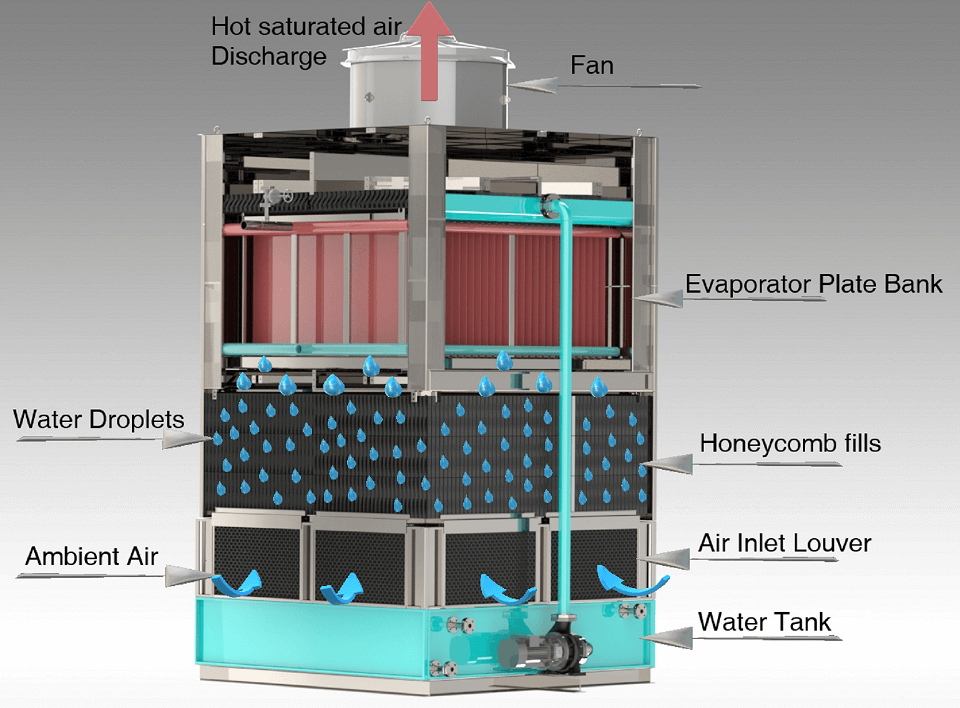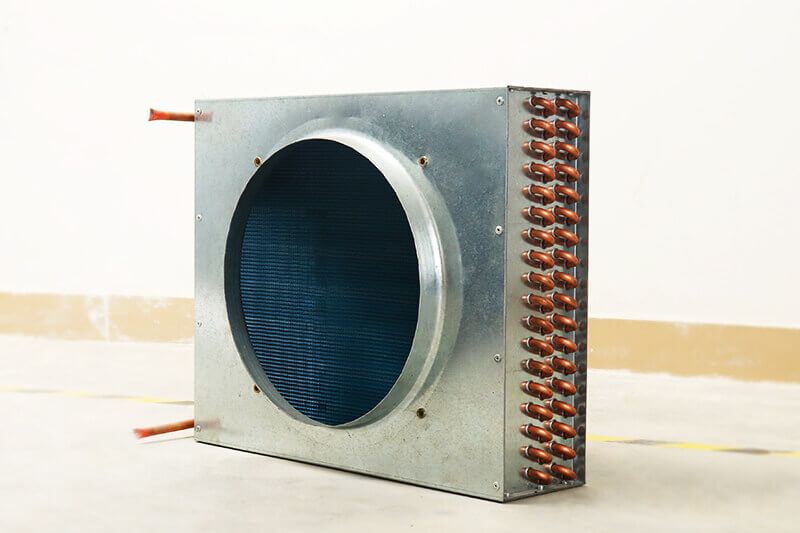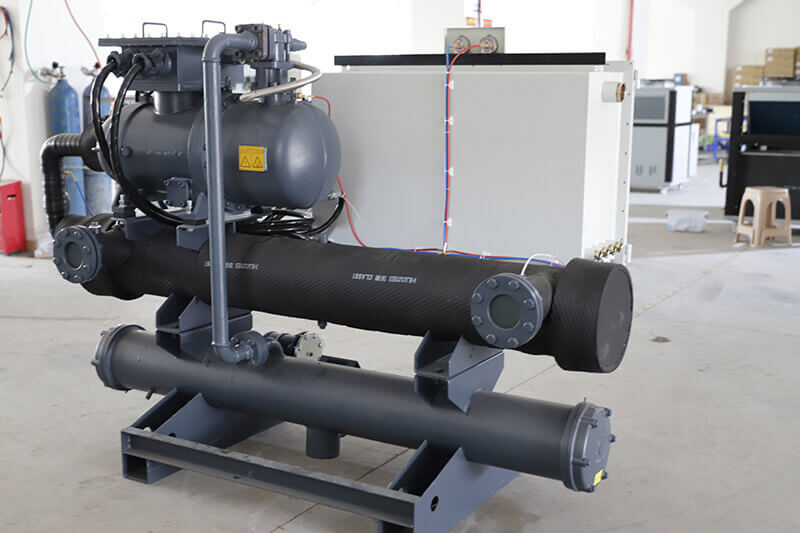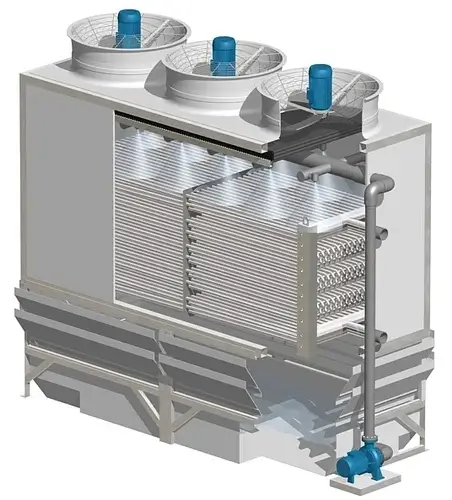What is an Evaporative Condenser?
An evaporative condenser represents a cornerstone technology in modern cooling systems, blending the principles of evaporation with traditional condensation methods to achieve superior heat dissipation. At its core, an evaporative condenser is designed to lower system condensing temperatures, effectively reducing compressor horsepower and, consequently, saving energy—up to 15% compared to conventional air-cooled systems.
At its core, an evaporative condenser is a specialized heat rejection device that combines the principles of both water evaporation with a condensing coil to efficiently cool and condense refrigerant vapor back into a liquid. Unlike traditional air-cooled systems that rely solely on air to dissipate heat, evaporative condensers leverage the cooling power of water evaporation alongside air flow to achieve lower system temperatures and, consequently, reduce the overall energy consumption of the cooling system.
Working Principle of Operation

The operation of an evaporative condenser can be likened to the feeling of coolness one experiences when stepping out of a pool on a hot day. The evaporating water on the skin absorbs heat from the body, leaving a refreshing sensation. Similarly, the evaporative condenser uses evaporation to remove heat from the system, thereby cooling the coolant or refrigerant vapor.
Evaporative condensers combine the principles of water cooling and air cooling. They use a fan to draw air through the condenser and over a water-sprayed coil. As the water evaporates, it absorbs heat from the refrigerant in the coil, effectively cooling it. This process benefits from the cooling effect of evaporation, making it more efficient than simple air cooling, especially in hot climates. Evaporative condensers are often used in places where water usage needs to be minimized since they consume less water than traditional water-cooled systems. They are suitable for various applications, including HVAC, refrigeration, and industrial processes.
This system is remarkably efficient due to the inherent properties of water and air. Water has a high latent heat of vaporization, meaning it can absorb a significant amount of heat during evaporation. Additionally, the evaporative condenser takes advantage of the fact that the dew point temperature (the temperature at which air becomes saturated and water vapor begins to condense) is usually lower than the actual air temperature. This difference allows the evaporative condenser to cool the refrigerant to temperatures closer to the dew point, significantly enhancing the cooling efficiency compared to air cooling alone.
Moreover, evaporative condensers distinguish themselves by their ability to tackle the challenge of excess heat in cooling systems, especially when the heat cannot be repurposed for other uses. This characteristic makes them particularly valuable in scenarios where the removal of excess heat is paramount to maintaining operational efficiency and system integrity.
Comparing with Air-Cooled Condensers

Air-cooled condensers expel heat from the refrigerant using ambient air. Fans blow across the condenser coils to dissipate the heat into the environment. These systems are particularly advantageous in scenarios where water resources are limited or in smaller applications. They are simpler in design and do not require a water supply or cooling tower, which can simplify installation and reduce costs. However, their efficiency can be significantly lower in hot climates since their cooling capacity is directly affected by the ambient air temperature.
Comparing with Water-cooled Condenser

Water-cooled condensers use water to remove heat from the refrigerant. In these systems, the refrigerant flows through coils or tubes, and water circulates around these coils or tubes to absorb the heat from the refrigerant. This heated water is then typically cooled in a cooling tower or rejected to another external source. Water-cooled condensers are highly efficient and are commonly used in large commercial and industrial applications where a reliable source of water is available. They require a separate cooling water system, which can add complexity and cost but provide high efficiency for heat rejection.
Key Differences Between Them
- Cooling Mechanism: Air-cooled condensers use ambient air, water-cooled condensers use water to directly cool the refrigerant, and evaporative condensers employ a combination of air cooling and water evaporation.
- Water Usage: Water-cooled condensers require a significant amount of water, air-cooled condensers do not use water, and evaporative condensers offer a middle ground by using water more efficiently.
- Efficiency: Air-cooled condensers may struggle in hot climates, water-cooled condensers consistently offer high efficiency, and evaporative condensers provide enhanced efficiency in warm conditions through the evaporative cooling effect.
Design Configurations
Evaporative condensers come in various design configurations, each tailored to optimize performance, efficiency, and application suitability. The two primary configurations found in these systems are combined flow and counterflow. Understanding these configurations is crucial for selecting the right evaporative condenser for specific cooling needs.

Combined Flow Configuration
The combined flow design ingeniously utilizes both a condensing coil and a fill surface for heat transfer, enhancing the condenser’s efficiency. This configuration allows for the parallel flow of air and spray water over the coil, coupled with a crossflow air/water interaction through the fill surface. In the parallel flow section, air and water move in the same direction over the coil, ensuring uniform cooling. The fill section introduces a crossflow pattern, where water descends vertically through the fill as air moves horizontally, promoting effective heat transfer.
The addition of the fill surface in the combined flow design serves a dual purpose. It not only aids in cooling but also minimizes water evaporation from the coil section. This reduction in evaporation is beneficial, as it decreases the potential for scaling and fouling on the coil, which are common challenges in evaporative cooling systems. By efficiently managing water usage and distribution, the combined flow configuration ensures optimal performance while mitigating maintenance concerns.
Counterflow Configuration
In contrast, the counterflow design operates with the air and spray water moving in opposite directions. This configuration features air traveling upward through the unit, while water is sprayed downward over the coil. The counterflow approach maximizes heat transfer efficiency by fully exploiting the temperature gradient between the air and the water, facilitating more effective cooling of the refrigerant vapor.
The counterflow configuration is distinguished by its ability to create a more uniform distribution of water over the coil, enhancing the cooling process. This design is particularly effective in scenarios where space is limited, as it can achieve a high cooling capacity in a compact footprint.
Fan System: Axial vs. Centrifugal Fans
Central to the effectiveness of evaporative condensers is the fan system, which can be equipped with either axial or centrifugal fans, each offering distinct advantages. Axial fans are known for their efficiency, requiring approximately half the motor horsepower of centrifugal fans for the same cooling capacity. This efficiency translates into significant energy savings over the lifespan of the system.
Centrifugal fans, on the other hand, are capable of overcoming external static pressure, making them suitable for a variety of installation environments, both indoor and outdoor. They are also inherently quieter than axial fans, although noise reduction technologies can minimize the difference, making axial fans competitive in noise-sensitive applications.
Draft Types: Induced vs. Forced Draft
Evaporative condensers utilize either induced draft or forced draft mechanisms to circulate air. Induced draft units have their fans mounted at the top, pulling air through the system. This arrangement minimizes noise impact and provides protection against fan icing in colder climates. Forced draft models, with fans located at the base, allow for easier access for maintenance and are designed to prolong component life by keeping them in the drier, entering air stream.
Each design configuration and component choice in evaporative condensers is aimed at optimizing performance, energy efficiency, and suitability for specific applications. By understanding these variations, operators can select the most appropriate system to meet their cooling requirements, ensuring efficient, reliable operation in their industrial or commercial settings.
Conclusion
Evaporative condensers offer a unique blend of efficiency, versatility, and environmental sustainability, making them an invaluable component in various cooling systems. As we’ve explored, their design configurations, such as combined flow and counterflow, along with the choice between axial and centrifugal fans, cater to a wide range of industrial and commercial applications. These systems are adept at reducing energy consumption, minimizing maintenance challenges, and adapting to space constraints while ensuring compliance with regulatory standards.
In conclusion, the adoption of evaporative condensers represents a smart investment in cooling technology, promising significant energy savings, operational efficiency, and a reduced environmental footprint. As the demand for more sustainable and cost-effective cooling solutions grows, the role of evaporative condensers is set to become increasingly central to meeting these challenges head-on, ensuring they remain a key component of industrial and HVAC systems worldwide.
